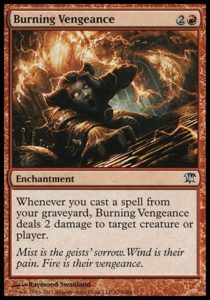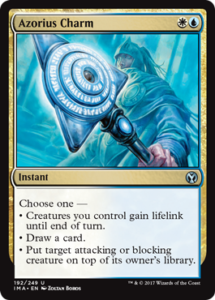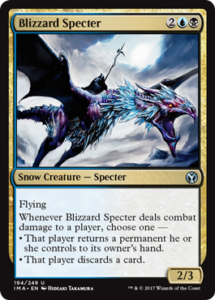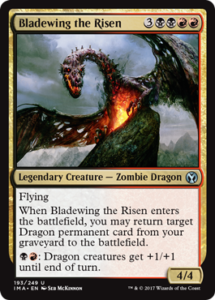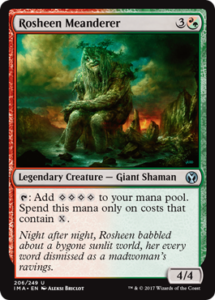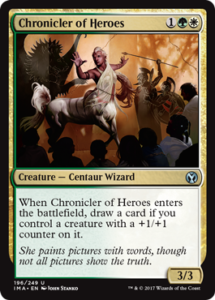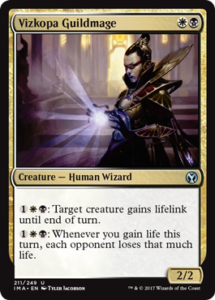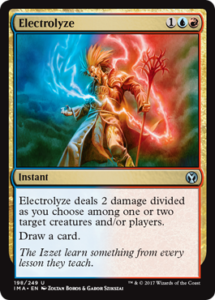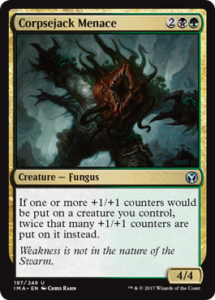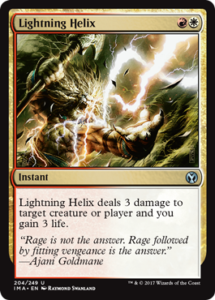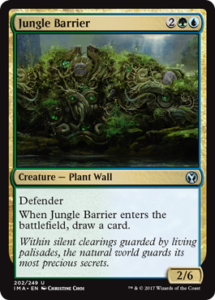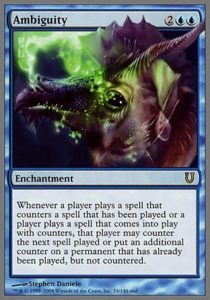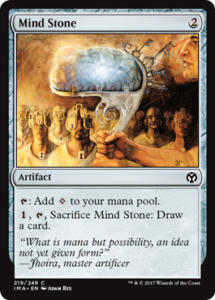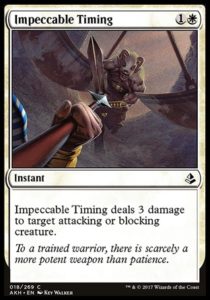It’s been two months since HasCon, and Iconic Masters will finally be available to the public this weekend. We here at Hipsters had the amazing fortune of being some of the only people to draft the format at HasCon, and we made a guide to the format back when the set was still being spoiled. Now that the format is nigh, let’s take a good look at what we now know and what you ought to know to play the format.
Archetypes
Masters formats have traditionally had mostly straightforward archetypes for each color combination. If you were a blue-black deck in MMA2013, you were a faeries deck, and if you were any other kind of blue deck you had little use for faeries. A UB deck in MMA2015 was a control deck maximizing the use of proliferation and -1/-1 counters. In EMA, UB was a reanimation deck that required uncommons to function well. In MMA2017, UB was a control deck in a format defined by multicolor goodstuff decks with cross-synergies.
Masters sets always have some oddball color combinations that either lack a particularly coherent archetype (RG in MMA2013), have a low average ceiling (UR Elementals in MMA2015, BG Dredge in MMA2013) or are so flexible as to not really have have an archetype (WB in EMA). MMA2017 was the outlier, as it was a format defined by multicolor decks.
Iconic Masters looks to have the most muddled archetypes in Masters history. This isn’t a bad thing, per say, but it’s worth noting that many archetypes aren’t straightforward “X matters” decks where you look to draft lots of Rebels/flashback spells/token makers. The multicolor uncommons, which are normally excellent signposts, underscore this nicely:
WU Tempo Skies feat. Prowess
Azorius Charm is a flexible card, but functions best as a Time Ebb on an attacking creature (since you cancel one attack and delay the next one, whereas you only deny a defensive opponent one block). It rewards tempo plays but also goes well in control decks. It’s not a strong signpost.
White-blue seems to be about fliers and tempo, but it also features some strong common prowess creatures in Seeker of the Way and Jhessian Thief. These creatures don’t interact ideally with Azorius Charm, since they work best when you cast spells while attacking. So, there’s some tension about how WU wants to play, and it looks to be more of a general goodstuff deck than an archetype that rewards you for drafting around a keyword.
UB Mill feat. Graveyard Counting
Blizzard Specter has nothing to do with milling, but is a fine card in its own right. It likely goes well in a hybrid mill/attack/skies strategy, as Jace’s Phantasm and Wight of Precinct Six suggest is viable.
Mill is a very parasitic strategy, which makes it both easy and risky to draft: you’re either all-in on milling your opponent out, or you’ve spent a lot of time and cards accomplishing nothing. Even a hybrid mill strategy, where you mill your opponent to set up your own creatures, means you’re unlikely to see competition for the cards you want unless someone else is in UB.
Despite the obscenely good mill deck Dana drafted back in September, I have low expectations of UB. There are no repeatable, quality sources of milling such as Vedalken Entrancer. Many of the millers either have mass appeal (Grisly Spectacle), insufficient support in UB (Doorkeeper), or are just plain bad (Shriekgeist). I look forward to being proven wrong again, but I don’t see this archetype functioning well without looping a Glimpse the Unthinkable with Mnemonic Wall.
BR Dragons
Bladewing the Risen is the first overt signal about what a color is supposed to do: play dragons. There are a lot of dragon synergies in the set, and while most of them are in red, Bladewing’s Thrall and Foul-Tongue Invocation will help dragons be a late-game value deck.
There’s one big problem with BR dragons: the paltry number of common and uncommon dragons. At common, you have Dragon Egg, Furnace Whelp, and Scion of Ugin. At uncommon, you’ve Noxious Dragon, Hoarding Dragon, and Bladewing the Risen. That’s six dragons (and two of the three common ones are quite bad), yet we have five common/uncommon dragon rewards: Dragonlord’s Servant, Dragon Tempest, Draconic Roar, Foul-Tongue Invocation, and Bladewing’s Thrall—and that’s not counting Bladewing, which is horribly overcosted if you don’t have a dragon to reanimate, or Dragonloft Idol, which is just awful.
There are plenty of excellent rare dragons, but every drafter is happy to play a Kokusho, the Evening Star or Thundermaw Hellkite. I expect BR to often be a classic B/R removal-heavy deck backed up with a few dragon synergies, unless you get the right bomb rares.
RG Big Mana…?
Rosheen Meanderer is perhaps the most confusing archetype signpost ever in a masters set. She instructs you to cast X-spells and costs. In RG, that means Ivy Elemental, Heat Ray, and Fireball (with Genesis Wave and Genesis Hydra at rare). Two of these cards don’t require any additional help or encouragement to be played. The third is Ivy Elemental.
Looking over the spoiler, I think RG is supposed to either be a generic goodstuff beatdown archetype or a necessary part of the Defenders deck. The correct way to use Rosheen is probably just as a Rhox Brute that randomly makes Fireballs slightly more amazing, and neither makes her particularly rewarding.
GW +1/+1 Counters
Chronicler of Heroes is straightforward. Play counters, get value.
GW is the one archetype I’ve drafted and I was shocked by how strong it was. It combines naturally powerful, inexpensive threats like the Khans Outlast creatures with all sorts of synergies. This seems like a solid foundation for a draft, particularly since a green counters-based deck can easily hedge into black.
WB Lifegain
Vizkopa Guildmage isn’t a strong card on its own, but there are plenty of lifegain synergies to combine it with. WB is a very parasitic A/B archetype, where sometimes you have Student of Ojutai and Ajani`s Pridemate awkwardly being horrible together, while other times you have a Tavern Swindler buying you free dragons with Angelic Accord. This looks like a fun archetype that can be unbeatable or fall apart, all based on its draws.
UR Spell Aggro
Electrolyze is back again, and just like Lightning Helix in red-white, it is a generically powerful card that says little about the archetype overall.
Make no mistake: UR is probably the fast aggro deck of the format. It combines the common Jhessian Thief with Kiln Fiend and Distortion Strike to generate value and damage as quickly as possible.
BG +1/+1 Counters
Corpsejack Menace demonstrates that GW and BG share a strategy, but where GW is about grinding value, BG is about beating face with Unleash creatures. Corpsejack Menace is a strong creature on its own, and unlike the other downshifted 4/4 for 4, Rosheen Meanderer, takes fine cards like Thrill-Kill Assassin and substantially improves them.
Having played both BG and GW, I expect BG to be the worse version of the deck, one you go into when white fails to be open or you get access to a bunch of Corpsejack Menaces and removal. BG has only one Outlast creature, so its worse at grinding out value and being flexible than GW, It tries to make up for this speed (its Unleash creatures force it to be the aggressor), but cards like Rakdos Drake and Dead Reveler just aren’t as powerful as what GW offers.
RW Flex-Aggro
Lightning Helix remains a generic good card that isn’t a signpost.
I was very impressed by the power of Trumpet Blast and Great Teacher’s Decree at HasCon, going 3-0 with a sealed deck. However, they go best with wide strategies, particularly tokens—which there isn’t a lot of support for. I found RW succeeded by attacking the board with midrange evasive creatures like Keldon Halberdiers and Serra Angel. That said, picking up a bunch of Infantry Veterans, Borderlands Marauders, Seeker of the Way, and Splatter Thugs seems viable in draft.
I expect RW to be a good color choice. It preys upon shenanigans, and is advantaged because so many archetypes have weak or rare-reliant strategies.
GU(r) Defenders
…eh, it’s still not as weird as UR Elementals.
Jungle Barrier isn’t an enabler. It’s just a generic reward for a player trying to grind opponents out with Doorkeeper or Vent Sentinel. And that’s it! Those are your only two kill conditions. There are twelve defenders in the set (all but one is in Temur colors), but only two can actually win you the game. This looks like a sweet archetype that can be the stalling backbone of a multicolor deck that uses rares to win.
And that’s the ten archetypes.
I admit, many seem rather tame compared to previous offerings. In addition, Iconic Masters is unusually full of random core set cards like Bogbrew Witch, Netcaster Spider, and Greater Basilisk. It looks like more games than usual will be won on the strength of generically good cards like Phantom Monster and Blinding Mage than one would normally expect from a Masters set. Still, that means Wizards is trying something different, and you can’t fault them for that.
…and now, let’s talk about the real important cards.
Big Mana, Big Mana, Big Mana
Mind Stone, Star Compass, Guardian Idol, and Manakin are commons. This is completely, patently absurd. These cards are probably the reason why everything seems so tame—because curves are substantially less meaningful, expensive creatures are all better than they seem. Angel of Mercy is below par for a five drop, but a Phantom Monster with upside on turn four. Phantom Monster is solid on its own, but it’s basically Serendib Efreet when you’ve got a Mind Stone.
So much of the format is pushing you to spend mana. Everything from Outlast creatures, to the rare dragons, to Mana Leak taxes your mana. Uncommon bouncelands, uncommon mana rocks, and two common rainbow lands make it possible to stretch your manabase to take on cross-color synergies (like Temur Defenders, Abzan Counters, or Jeskai Prowess) or splash powerful rares. I expect that the best decks will either have insanely potent synergies, a crazy low aggressive curve, or lots of mana acceleration and bombs to ramp out.
I think Iconic Masters and MMA2017 have a lot in common in how they’ll play out, even though they arrive there via different means. MMA2017 was an overtly three-color set with very few color-specific shenanigans to chase. IMA isn’t an overtly multicolor set, but its relatively thin and weak archetypes, combined with rampant colorless mana, allow decks to rely on individual overpowered cards rather than synergies (though there will be loads of synergies to rely on).
A Parting Note
Iconic Masters may be a victim of several circumstances having nothing to do with its design. It’s releasing in the middle of Unstable spoiler season (and right before a major American holiday), so many folks’ minds are elsewhere. It was spoiled two months ago, and as we know from New Phyrexia, early spoilers can cool a set’s reception. It has a generic, nondescriptive name, so players don’t know what to expect—at least Modern Masters tells you what time period to expect cards from, and that you’ll likely see some familiar archetypes. Lastly, both 25th Anniversary Masters and Dominaria come out next year, so much of the nostalgia that could’ve been packed into IMA is likely being saved for later. There’s a lot of good in IMA, and a lot of weird—it’s a shame that the spotlight isn’t on it as much as it could be.
I look forward to getting in an IMA draft or two at PAX Unplugged this weekend and seeing just how on or off the mark my two-month old impressions and current predictions are. Hopefully, the set is a weird, off-the-wall blast to play, where Channel+Fireball will remind players of the first grand Magic combo, Mana Drain and Flusterstorms will be golden tickets, and Tavern Swindlers will reign supreme.
And, as always, thanks for reading!
—Zachary Barash
Zachary Barash is a New York City-based game designer. He works for Kingdom Death: Monster, has an MFA in Game Design from NYU, and does freelance game design.
His favorite card of the month is Guard Duty. It’s half of a Pacifism in every sense of the word, except for word count.

